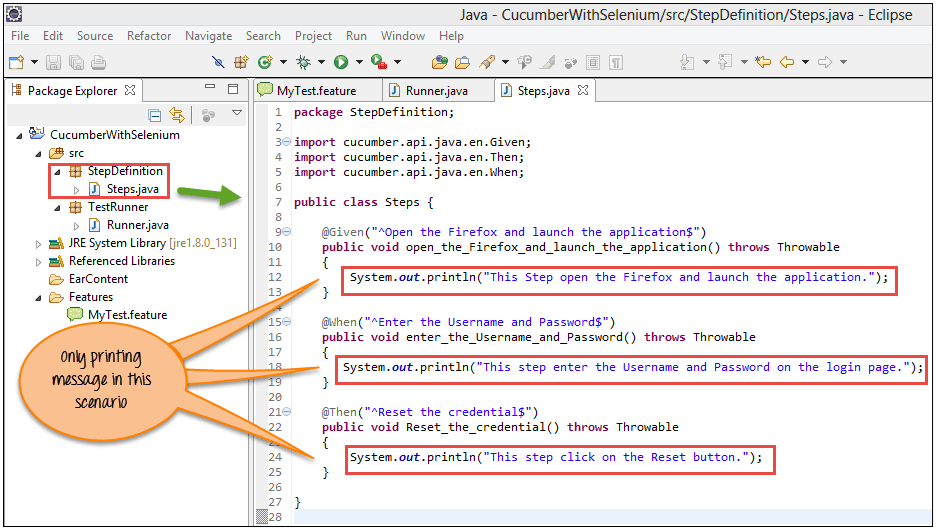WebApplication Singleton driver Factory Design Pattern :
Follow the link: https://www.linkedin.com/pulse/create-singleton-webdriverfactory-pattern-java-using-class-gainewar/
Mobile Singleton driver Factory Design Pattern :
- AppiumServerJava : is used to customize the url and desirecapabilities
- CreateDriver : is to create LocalThread instance
Package Runner;
import java.io.IOException;
import java.net.MalformedURLException;
import java.net.URL;
import org.apache.log4j.Logger;
import org.apache.log4j.xml.DOMConfigurator;
import org.apache.commons.cli.CommandLine;
import org.apache.log4j.Logger;
import org.openqa.selenium.WebDriver;
import org.openqa.selenium.remote.DesiredCapabilities;
import org.openqa.selenium.remote.RemoteWebDriver;
import org.testng.annotations.BeforeClass;
import org.testng.annotations.BeforeSuite;
import io.appium.java_client.android.AndroidDriver;
import io.appium.java_client.remote.AndroidMobileCapabilityType;
import io.appium.java_client.remote.MobileCapabilityType;
import io.appium.java_client.remote.MobilePlatform;
import io.appium.java_client.service.local.AppiumDriverLocalService;
import io.appium.java_client.service.local.AppiumServiceBuilder;
public class AppiumServerJava {
private static DesiredCapabilities cap;
public static AndroidDriver driver;
public static AppiumServiceBuilder builder = null;
static AppiumDriverLocalService service = null;
private static Logger Log = Logger.getLogger(AppiumServerJava.class);
// @BeforeSuite
public static DesiredCapabilities AppiumServerCapabilities() {
DOMConfigurator.configure(System.getProperty("user.dir") + File.separator + "log4j.xml");
Log.debug("This is debug message ");
Log.info("desire capabilities initized");
File appDir = new File(System.getProperty("user.dir") + "/src/test/java/appStore/");
File app = new File(appDir, "Flipkart Online Shopping App_v6.17_apkpure.com.apk");
Log.info(app + "_____");
cap = new DesiredCapabilities(); // Cabaliliesties for server
cap.setCapability("noReset", "false");
// cap.setCapability(MobileCapabilityType.BROWSER_NAME, "Android");
cap.setCapability(MobileCapabilityType.UDID, "4200cab8de3b747f"); // Give Device ID of your mobile phone
cap.setCapability(MobileCapabilityType.APP, app.getAbsolutePath());
cap.setCapability(MobileCapabilityType.DEVICE_NAME, "Galaxy On Max");
cap.setCapability(MobileCapabilityType.PLATFORM_NAME, MobilePlatform.ANDROID);
cap.setCapability(AndroidMobileCapabilityType.APP_PACKAGE, "com.flipkart.android");
cap.setCapability("appActivity", "com.flipkart.android.SplashActivity");
builder = new AppiumServiceBuilder().withCapabilities(cap);
DesiredCapabilities capClient = new DesiredCapabilities(); // Capabilities for client
return cap;
}
public static String getURL() {
AppiumServerCapabilities();
service = builder.build();
Log.info("appium service started ");
service.start();
Log.error(service.getUrl().toString());
return service.getUrl().toString();
}
}
| |||||
|
Reference : https://www.vinsguru.com/selenium-webdriver-factory-design-pattern-using-java-8-supplier/
3. Driver Factory using Maven dependency
<dependency>
<groupId>ru.stqa.selenium</groupId>
<artifactId>webdriver-factory</artifactId>
<version>4.4</version>
</dependency>
<dependency>
<groupId>org.seleniumhq.selenium</groupId>
<artifactId>selenium-java</artifactId>
<version>3.141.59</version>
</dependency>
The library provides three ways to manage instances:
- SingleWebDriverPool allows a single managed instance of WebDriver to exist at any given moment,
- ThreadLocalSingleWebDriverPool allows a single managed instance of WebDriver to exist for each thread,
- LooseWebDriverPool does not impose any restrictions, it creates a new managed instance on each request.
You can use as many separate pools as you like, but there is also WebDriverPool.DEFAULT that is an instance of ThreadLocalSingleWebDriverPool.
import ru.stqa.selenium.factory.WebDriverPool;
// adding desirecapabilities;
@BeforeEach public void initDriver() throws Throwable {
driver = WebDriverPool.DEFAULT.getDriver(gridHubUrl, capabilities);
}
// Start Browser :
@BeforeMethod public void startBrowser() {
driver = WebDriverPool.DEFAULT.getDriver(DesiredCapabilities.firefox());
}
@Test
public void testSomething() {
WebDriver driver = WebDriverPool.DEFAULT.getDriver(new FirefoxOptions());
// do something with the driver
driver.get("http://seleniumhq.org/");
}
@Test
public void testSomethingElse() {
WebDriver driver = WebDriverPool.DEFAULT.getDriver(new ChromeOptions());
// do something with the driver
driver.get("http://seleniumhq.org/");
}
@AfterSuite
public void stopAllDrivers() {
WebDriverPool.DEFAULT.dismissAll();
}
Reference : https://github.com/barancev/webdriver-factory
4.








